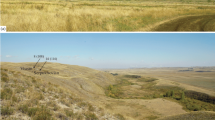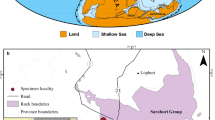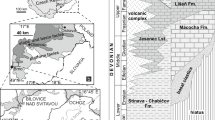Abstract
Elmira is a medium-to-large gastropod of uncertain systematic affinity, which has so far been reported only from a presumably Eocene methane-seep deposit in Cuba. This study reports a mass occurrence of Elmira shimantoensis Kiel and Nobuhara sp. nov. from a Late Cretaceous hydrocarbon-seep deposit in Shikoku, Japan, called the Sada Limestone. Its paleoecology is reconstructed based on its mode of occurrence, carbonate petrology, and stable carbon isotope analyses. The fauna of the Sada Limestone in general is characterized by an abundance of large chemosymbiotic bivalves of the family Thyasiridae and of “Serpula” tubes. The mass occurrence of Elmira shimantoensis was found in a lens-shaped carbonate body with a flat top and a concave base, 6.5 m in length and less than 2 m in thickness, consisting of multiple layers of shell accumulations, which were formed by shell-winnowing and the filling of a depression in slope mud. The scarcity of Elmira shimantoensis elsewhere in the Sada Limestone suggests that it formed locally from a gregarious population in the vicinity of the depression, possibly on hard ground. The matrix of the mass occurrence is rich in dolomite and ankerite, and is less depleted in 13C (δ13C values of calcite: −5.3 to −2.4 ‰; of dolomite: −8.3 ‰) than the matrix of the enclosing thyasirid-rich and tube-rich limestones. This suggests that the gastropod mass occurrence was cemented below the sulfate reduction zone and has thus undergone little anaerobic methane oxidation. Therefore, Elmira shimantoensis is reconstructed here as a bacteria grazer on a hard substrate such as exposed carbonate mounds rather than as a species that relied on chemosynthetic symbionts for nutrition.
Kurzfassung
Elmira ist eine mittelgroße bis große Schnecke ungeklärter systematischer Stellung, die bisher nur aus einem vermutlich eozänen Methanquellen-Karbonat auf Kuba bekannt war. In der vorliegenden Arbeit wird ein Massenvorkommen von Elmira shimantoensis sp. nov. im Sada Limestone–Ablagerungen einer oberkretazischen Kohlenwasserstoff-Quelle in Shikoku in Japan–beschrieben und seine Paläoökologie basierend auf der Art des Fossilvorkommens, der Karbonatmikrofazies und der Analyse von stabilen Isotopen rekonstruiert. Die wichtigsten Faunenelemente des Sada Limestone sind Massenvorkommen der großen, chemosymbiontischen Muschel ‘Thyasira’ hataii und von Röhren von serpuliden Würmern. Das Massenvorkommen von Elmira shimantoensis befindet sich in einer etwa 6.5 m langen und fast 2 m hohen Kalklinse mit einer flachen Oberseite und einer konkaven Basis, besteht aus mehreren fossilreichen Lagen, und entstand vermutlich durch Ablagerung und Auswaschung der Schalen in einer Vertiefung im Meeresboden. Da Elmira shimantoensis außerhalb des Massenvorkommens sehr selten ist, wird vermutet, dass sie gehäuft in der Nähe des Einbettungsortes gelebt hat. Die Matrix des Massenvorkommens ist reich an Dolomit und Ankerit und ist weniger stark an 13C abgereichert (δ13C-Werte des Kalzits: –5.3 bis –2.4 ‰; des Dolomits: –8.3 ‰) als die der umgebenden Thyasiriden- und Wurmröhren-reichen Kalke. Das deutet darauf hin, dass die Zementation des Schnecken-Massenvorkommens unterhalb der Sulfatreduktionszone, und damit nur unter geringem Einfluss anaerober Methanoxidation, stattfand. Wir vermuten, dass Elmira shimantoensis Bakterienmatten von Hardgründen abweidete und nicht chemosymbiontisch lebte.















Similar content being viewed by others
References
Amano, K., and S. Kiel. 2007. Fossil vesicomyid bivalves from the North Pacific Region. Veliger 49: 270–293.
Baker, P.A., and M. Kastner. 1981. Constraints on the formation of sedimentary dolomite. Science 213: 214–216.
Beesley, P.L., G.J.B. Ross, and A. Wells. 1998. Mollusca: The Southern Synthesis. Fauna of Australia. vol. 5, Part B, 565–1234. Melbourne: CSIRO Publishing.
Both, R., K. Crook, B. Taylor, S. Brogan, B. Chappell, E. Frankel, L. Lui, J. Sinton, and D. Tiffin. 1986. Hydrothermal chimneys and associated fauna in the Manus back-arc basin, Papua New Guinea. EOS, Transaction American Geophysical Union 67: 489–490.
Campbell, K.A., and D.J. Bottjer. 1995. Brachiopods and chemosymbiotic bivalves in Phanerozoic hydrothermal vent and cold seep environments. Geology 23: 321–324.
Chen, C., J.T. Copley, K. Linse, A.D. Rogers, and J.D. Sigwart. 2015a. The heart of a dragon: 3D anatomical reconstruction of the scaly-foot gastropod (Mollusca: Gastropoda: Neomphalina) reveals its extraordinary circulatory system. Frontiers in Zoology 12: 13. doi:10.1186/s12983-015-0105-1.
Chen, C., K. Linse, J.T. Copley, and A.D. Rogers. 2015b. The scaly-foot gastropod: a new genus and species of hydrothermal vent-endemic gastropod (Neomphalina: Peltospiridae) from the Indian Ocean. Journal of Molluscan Studies 81: 322–334.
Chen, C., K. Linse, C.N. Roterman, J.T. Copley, and A.D. Rogers. 2015c. A new genus of large hydrothermal vent-endemic gastropod (Neomphalina: Peltospiridae). Zoological Journal of the Linnaean Society 175: 319–335.
Cooke, C.W. 1919. Contributions to the geology and palaeontology of the West Indies IV. Tertiary mollusks from the Leeward islands and Cuba. Carnegie Institution of Washington Publications 291: 103–156.
Cordes, E.E., S. Hourdez, and H.H. Roberts. 2010. Unusual habitats and organisms associated with the cold seeps of the Gulf of Mexico. In The Vent and Seep Biota, ed. S. Kiel, 315–332. Heidelberg: Springer.
Dando, P.R., and A.J. Southward. 1986. Chemoautotrophy in bivalve molluscs of the genus Thyasira. Journal of the Marine Biological Association of the United Kingdom 66: 915–929.
Díaz-del-Río, V., L. Somoza, J. Martínez-Frias, M.P. Mata, A. Delgado, F.J. Hernandez-Molinad, R. Lunar, J.A. Martín-Rubí, A. Maestro, M.C. Fernández-Puga, R. León, E. Llave, T. Medialdea, and J.T. Vázquez. 2003. Vast fields of hydrocarbon-derived carbonate chimneys related to the accretionary wedge/olistostrome of the Gulf of Cádiz. Marine Geology 195: 177–200.
Fretter, V. 1989. The anatomy of some new archaeogastropod limpets (Superfamily Peltospiracea) from hydrothermal vents. Journal of Zoology 218: 123–169.
Fujikura, K., T. Sasaki, T. Yamamoto, and T. Yoshida. 2009. Turrid whelk, Phymorhynchus buccinoides feeds on Bathymodiolus mussels at a seep site in Sagami Bay, Japan. Plankton and Benthos Research 4: 23–30.
Greinert, J., G. Bohrmann, and E. Suess. 2001. Gas hydrate-associated carbonates and methane-venting at Hydrate Ridge: classification, distribution and origin of authigenic lithologies. In Natural Gas Hydrates: Occurrence, Distribution and Detection, AGU Geophysical Monograph 124, eds. C. K. Paull and W. K. Dillon, 99–113. Washington, DC: American Geophysical Union.
Hedegaard, C. 1997. Shell structures of the recent Vetigastropoda. Journal of Molluscan Studies 63: 369–377.
Hikida, Y., S. Suzuki, Y. Togo, and A. Ijiri. 2003. An exceptionally well-preserved fossil seep community from the Cretaceous Yezo Group in the Nakagawa area, Hokkaido, northern Japan. Paleontological Research 7: 329–342.
Ichikawa, K., and Y. Maeda. 1958. Late Cretaceous pelecypods from the Izumi Group. Part 2. Orders Taxodontida, Prionodontida, Dysodontida, Desmodontida and Adapedontida. Journal of the Institute of Polytechnics, Osaka City University, Series G 4: 71–122.
Ishimura, T., U. Tsunogai, and T. Gamo. 2004. Stable carbon and oxygen isotopic determination of sub-microgram quantities of CaCO3 to analyze individual foraminiferal shells. Rapid Communications in Mass Spectrometry 18: 2883–2888.
Ishimura, T., U. Tsunogai, and F. Nakagawa. 2008. Grain-scale heterogeneities in the stable carbon and oxygen isotopic compositions of the international standard calcite materials (NBS 19, NBS 18, IAEA-CO-1, and IAEA-CO-8). Rapid Communications in Mass Spectrometry 22: 1925–1932.
Jørgensen, N.O. 1992. Methane-derived carbonate cementation of marine sediments from the Kattegat, Denmark: geochemical and geological evidence. Marine Geology 103: 1–13.
Juniper, S.K., and M. Sibuet. 1987. Cold seep benthic communities in Japan subduction zones: spatial organization, trophic strategies and evidence for temporal evolution. Marine Ecology Progress Series 40: 115–126.
Kaim, A., R.G. Jenkins, and Y. Hikida. 2009. Gastropods from Late Cretaceous Omagari and Yasukawa hydrocarbon seep deposits in the Nakagawa area, Hokkaido, Japan. Acta Palaeontologica Polonica 54: 463–490.
Kaim, A., R.G. Jenkins, K. Tanabe, and S. Kiel. 2014. Mollusks from late Mesozoic seep deposits, chiefly in California. Zootaxa 3861: 401–440.
Kaim, A., R.G. Jenkins, and A. Warén. 2008. Provannid and provannid-like gastropods from the Late Cretaceous cold seeps of Hokkaido (Japan) and the fossil record of the Provannidae (Gastropoda: Abyssochrysoidea). Zoological Journal of the Linnean Society 154: 421–436.
Kaim, A., B.E. Tucholke, and A. Warén. 2012. A new Late Pliocene large provannid gastropod associated with hydrothermal venting at Kane Megamullion, Mid-Atlantic Ridge. Journal of Systematic Palaeontology 10: 423–433.
Kano, H., K. Yamamoto, and M. Okamura. 2003. Lithostratigraphy of the Domeki Formation in the Nakamura and Sukumo Cities, Southwestern Shikoku, and its depositional setting as a slope-basin deposit. Research Reports of Kochi University, Natural Science 52: 1–24. (in Japanese with English abstract).
Katto, J., and M. Hattori. 1964. Some Veneridae from the Shimantogawa Group in the Outer Zone of Shikoku, Japan. Research Reports of the Kochi University, Natural Science 13: 7–10.
Kiel, S. 2004. Shell structures of selected gastropods from hydrothermal vents and seeps. Malacologia 46: 169–183.
Kiel, S. 2015. Did shifting seawater sulfate concentrations drive the evolution of deep-sea methane-seep ecosystems? Proceedings of the Royal Society B 282: 20142908.
Kiel, S., and K. Amano. 2013. The earliest bathymodiolin mussels: an evaluation of Eocene and Oligocene taxa from deep-sea methane seep deposits in western Washington State, USA. Journal of Paleontology 87: 589–602.
Kiel, S., K.A. Campbell, W.P. Elder, and C.T.S. Little. 2008. Jurassic and Cretaceous gastropods from hydrocarbon seeps in forearc basin and accretionary prism settings, California. Acta Palaeontologica Polonica 53: 679–703.
Kiel, S., and P.R. Dando. 2009. Chaetopterid tubes from vent and seep sites: Implications for fossil record and evolutionary history of vent and seep annelids. Acta Palaeontologica Polonica 54: 443–448.
Kiel, S., and B.T. Hansen. 2015. Cenozoic methane-seep faunas of the Caribbean region. PLoS One 10: e0140788.
Kiel, S., J. Glodny, D. Birgel, L.G. Bulot, K.A. Campbell, C. Gaillard, R. Graziano, A. Kaim, I. Lazar, M.R. Sandy, and J. Peckmann. 2014. The paleoecology, habitats, and stratigraphic range of the enigmatic cretaceous brachiopod Peregrinella. PLoS One 9: e109260.
Kiel, S., and J. Peckmann. 2007. Chemosymbiotic bivalves and stable carbon isotopes indicate hydrocarbon seepage at four unusual Cenozoic fossil localities. Lethaia 40: 345–357.
Little, C.T.S., and R.C. Vrijenhoek. 2003. Are hydrothermal vent animals living fossils? Trends in Ecology and Evolution 18: 582–588.
Matsumoto, T. 1980. Cephalopods from the Shimanto Belt of Kochi Prefecture, Shikoku, Japan. In Geology and Paleontology of the Shimanto Belt: Selected Papers in Honor of Professor Jiro Katto, eds. A. Taira and M. Tashiro, 283–298. Kochi: Rinyakosaikai Press. (in Japanese).
Martin, R.E. 1999. Taphonomy: A Process Approach. Cambridge: Cambridge University Press. 508.
McCrea, J.M. 1950. On isotope chemistry of carbonates and paleotemperature scale. Journal of Chemical Physics 18: 849–857.
Nakamura, K., H. Watanabe, J. Miyazaki, K. Takai, S. Kawagucci, T. Noguchi, S. Nemoto, T.-O. Watsuji, T. Matsuzaki, T. Shibuya, K. Okamura, M. Mochizuki, Y. Orihashi, T. Ura, A. Asada, D. Marie, M. Koonjul, M. Singh, G. Beedessee, M. Bhikajee, and K. Tamaki. 2012. Discovery of new hydrothermal activity and chemosynthetic fauna on the Central Indian Ridge at 18–20 S. PLoS One 7: e32965.
Nobuhara, T., D. Onda, N. Kikuchi, Y. Kondo, K. Matsubara, K. Amano, R.G. Jenkins, Y. Hikida, and R. Majima. 2008. Lithofacies and fossil assemblages of the Upper Cretaceous Sada Limestone, Shimanto City, Kochi Prefecture, Shikoku, Japan. Fossils 84: 47–60. (in Japanese with English abstract).
Okutani, T., and S. Ohta. 1988. A new gastropod mollusk associated with hydrothermal vents in the Mariana Back-Arc Basin, Western Pacific. Venus 47: 1–9.
Peckmann, J., D. Birgel, and S. Kiel. 2009. Molecular fossils reveal fluid composition and flow intensity at a Cretaceous seep. Geology 37: 847–850.
Peckmann, J., E. Gischler, W. Oschmann, and J. Reitner. 2001. An Early Carboniferous seep community and hydrocarbon-derived carbonates from the Harz Mountains, Germany. Geology 29: 271–274.
Rogers, A.D., P. Tyler, D.P. Connelly, J.T. Copley, R. James, R.D. Larter, K. Linse, R.A. Mills, A.N. Garabato, R.D. Pancost, D.A. Pearce, N.V.C. Polunin, C.R. German, T. Shank, P.H. Boersch-Supan, B.J. Alker, A. Aquilina, S.A. Bennett, A. Clarke, R.J.J. Dinley, A.G.C. Graham, D.R.H. Green, J.A. Hawkes, L. Hepburn, A. Hilario, V.A.I. Huvenne, L. Marsh, E. Ramirez-Llodra, W.D.K. Reid, C.N. Roterman, C.J. Sweeting, S. Thatje, and K. Zwirglmaier. 2012. The discovery of new deep-sea hydrothermal vent communities in the Southern Ocean and implications for biogeography. PLoS Biology 10: 1–17.
Sasaki, T., K. Fujikura, and T. Okutani. 2007. Molluscs collected in the cruise NT06-04 of R/V Natsushima from methane-seeps off Hatsushima Island, Sagami Bay, Japan. Chiribotan 37: 197–207. (in Japanese with English abstract).
Sasaki, T., A. Wáren, Y. Kano, T. Okutani, and K. Fujikura. 2010. Gastropods from recent hot vents and cold seeps: systematics, diversity and life strategies. In The Vent and Seep Biota, ed. S. Kiel, 169–254. Heidelberg: Springer.
Sharma, T., and R.N. Clayton. 1965. Measurement of O18/O16 ratios of total oxygen of carbonates. Geochimica Cosmochimca Acta 29: 1347–1353.
Stein, J.L., S.C. Cary, R.R. Hessler, S. Ohta, R.D. Vetter, J.J. Childress, and H. Beck. 1988. Chemoautotrophic symbiosis in a hydrothermal vent gastropod. The Biological Bulletin 174: 373–378.
Takeuchi, R., H. Machiyama, and R. Matsumoto. 2001. Carbonate formation related to methane hydrate dissociation, an example from the cold seep carbonates on the Kuroshima Knoll. Journal of the Sedimentological Society of Japan 53: 99–101. (in Japanese with English abstract).
Taira, A., M. Tashiro, M. Okamura, and J. Katto. 1980. The geology of the Shimanto Belt in Kochi Prefecture, Shikoku, Japan. In Geology and Paleontology of the Shimanto Belt: Selected Papers in Honor of Professor Jiro Katto, ed. A. Taira, and M. Tashiro, 319–389. Kochi: Rinyakosaikai Press. [in Japanese].
Tashiro, M. 1980. The bivalve fossils from the Shimano Belt of Kochi Prefecture and their biostratigraphic implications. In Geology and Paleontology of the Shimanto Belt: Selected Papers in Honor of Professor Jiro Katto, ed. A. Taira, and M. Tashiro, 249–264. Kochi: Rinyakosaikai Press. (in Japanese).
Tashiro, M. 1991. The North subbelt of Shimanto Belt in the western part of Shikoku. In Regional Geology of Japan Part 8 Shikoku, ed. K. Suyari, M. Iwasaki, and T. Suzuki, 89–91. Tokyo: Kyoritsu Shuppan Co., Ltd. (in Japanese).
Taylor, J.D., and E.A. Glover. 2010. Chemosynbiotic bivalves. In The Vent and Seep Biota, ed. S. Kiel, 107–136. Heidelberg: Springer.
Van Dover, C.L. 2000. The Ecology of Deep-Sea Hydrothermal Vents, 412. Princeton: Princeton University Press.
Van Dover, C.L., S.E. Humphris, D. Fornari, C.M. Cavanaugh, R. Collier, S.K. Goffredi, J. Hashimoto, M.D. Lilley, A.L. Reysenbach, T.M. Shank, K.L. Von Damm, A. Banta, R.M. Gallant, D. Götz, D. Green, J. Hall, T.L. Harmer, L.A. Hurtado, P. Johnson, Z.P. McKiness, C. Meredith, E. Olson, I.L. Pan, M. Turnipseed, Y. Won, C.R. Young III, and R.C. Vrijenhoek. 2001. Biogeography and ecological setting of Indian Ocean hydrothermal vents. Science 294: 818–823.
Vinn, O., E.K. Kupriyanova, and S. Kiel. 2013. Serpulids (Annelida, Polychaeta) at Cretaceous to modern hydrocarbon seeps: ecological and evolutionary patterns. Palaeogeography Palaeoclimatology Palaeoecology 390: 35–41.
Warén, A., S. Bengston, S.K. Goffredi, and C.L. Van Dover. 2003. A hot-vent gastropod with iron sulfide dermal sclerites. Science 32: 1007.
Acknowledgments
We thank Ryuichi Majima (Yokohama National University), Kazutaka Amano (Joetsu University of Education), Yoshinori Hikida (Nakagawa Museum of Natural History), and Robert G. Jenkins (Kanazawa University) for discussions during fieldwork, and Jörn Peckmann (University of Hamburg) for discussions of carbonate petrography. A detailed topographical survey of the study area was performed by Meiji Consultant Co. Ltd. under the direction of Masato Taniguchi and Futoshi Akamatsu (In Situ Solutions Co., Ltd. at present). We are also indebted to Kenji Kusunoki (Shizuoka University) and Axel Hackmann (University of Göttingen) for thin-section preparation. Our special thanks go to Alexander Nützel (Ludwig-Maximilians-Universität München) and Andrzej Kaim (Polish Academy of Science) for their helpful comments that allowed us to improve our manuscript. The fieldwork was permitted by the Residents’ Association of Sada Village. Financial support was provided by JSPS KAKENHI (18340165 and 23540548 to T.N., 25701002 to T.I.: Grant-in-Aid for Scientific Research from the Japan Society for the Promotion of Science), and also by the FWF–Der Wissenschaftsfonds, Austria, through a Lise Meitner fellowship, and by Joetsu University of Education, Japan, through a visiting scientist grant to S.K.
Author information
Authors and Affiliations
Corresponding author
Additional information
Communicated by Mike Reich.
Rights and permissions
About this article
Cite this article
Nobuhara, T., Onda, D., Sato, T. et al. Mass occurrence of the enigmatic gastropod Elmira in the Late Cretaceous Sada Limestone seep deposit in southwestern Shikoku, Japan. PalZ 90, 701–722 (2016). https://doi.org/10.1007/s12542-016-0326-4
Received:
Accepted:
Published:
Issue Date:
DOI: https://doi.org/10.1007/s12542-016-0326-4




